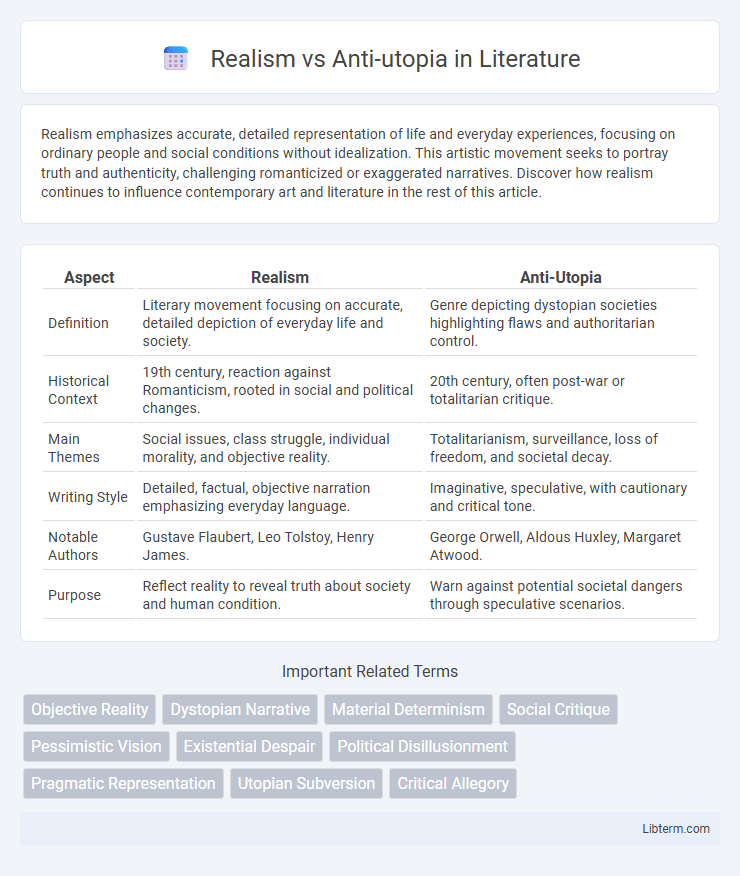Realism emphasizes accurate, detailed representation of life and everyday experiences, focusing on ordinary people and social conditions without idealization. This artistic movement seeks to portray truth and authenticity, challenging romanticized or exaggerated narratives. Discover how realism continues to influence contemporary art and literature in the rest of this article.
Table of Comparison
| Aspect | Realism | Anti-Utopia |
|---|---|---|
| Definition | Literary movement focusing on accurate, detailed depiction of everyday life and society. | Genre depicting dystopian societies highlighting flaws and authoritarian control. |
| Historical Context | 19th century, reaction against Romanticism, rooted in social and political changes. | 20th century, often post-war or totalitarian critique. |
| Main Themes | Social issues, class struggle, individual morality, and objective reality. | Totalitarianism, surveillance, loss of freedom, and societal decay. |
| Writing Style | Detailed, factual, objective narration emphasizing everyday language. | Imaginative, speculative, with cautionary and critical tone. |
| Notable Authors | Gustave Flaubert, Leo Tolstoy, Henry James. | George Orwell, Aldous Huxley, Margaret Atwood. |
| Purpose | Reflect reality to reveal truth about society and human condition. | Warn against potential societal dangers through speculative scenarios. |
Understanding Realism: Definition and Core Principles
Realism, a literary and artistic movement emerging in the 19th century, emphasizes accurate, detailed depictions of everyday life and society without romanticization or idealization. Its core principles include objectivity, focusing on characters' social environments, and portraying the complexities of human behavior and social conditions. Realism seeks to reflect the world truthfully, often highlighting ordinary experiences and social issues to prompt critical reflection.
The Essence of Anti-Utopia: Meaning and Origins
The essence of anti-utopia lies in its portrayal of dystopian societies that reflect the darkest consequences of political and social ideologies, contrasting sharply with the idealistic visions of realism. Emerging from historical contexts marked by totalitarian regimes and technological anxieties, anti-utopias expose the disillusionment with utopian promises by depicting oppressive, dehumanizing environments. This genre critically examines the origins of societal failures through symbolic narratives that challenge the optimistic assumptions inherent in realist perspectives.
Historical Roots of Realism in Literature and Art
Realism in literature and art emerged in the mid-19th century as a response to Romanticism, emphasizing accurate, detailed depictions of everyday life and social conditions. Rooted in the socio-political changes of the Industrial Revolution and urbanization, Realism sought to represent the ordinary experiences of characters without idealization or exaggerated emotion. This historical movement laid the groundwork for contrasting genres like anti-utopia, which critique societal flaws through speculative, often dystopian narratives.
The Rise of Anti-Utopian Thought in Modern Society
The rise of anti-utopian thought in modern society reflects widespread skepticism toward idealized visions of perfect social orders, emphasizing instead the flaws and unintended consequences inherent in utopian ideologies. Realism counters by grounding expectations and policies in practical, empirical realities, acknowledging human limitations and societal complexities. This tension shapes contemporary political and cultural discourse, highlighting concerns about authoritarianism, surveillance, and loss of individual freedoms often depicted in anti-utopian narratives.
Key Philosophers and Authors of Realism vs Anti-Utopia
Key philosophers of realism include Thomas Hobbes, who emphasized the anarchic nature of the international system, and Hans Morgenthau, who developed political realism based on power and national interest. Prominent anti-utopian authors such as George Orwell and Aldous Huxley critiqued idealistic visions through dystopian novels like *1984* and *Brave New World*, highlighting the dangers of totalitarianism and technological control. Realism prioritizes pragmatic governance and survival, whereas anti-utopian literature warns against the loss of individual freedoms in ostensibly perfect societies.
Major Differences Between Realism and Anti-Utopia
Realism in literature and art emphasizes accurate, detailed depictions of everyday life and society, often highlighting social issues and the human condition without idealization. Anti-utopia, or dystopian fiction, presents a bleak, exaggerated vision of society, exposing flaws and potential dangers of political systems, technology, or human nature through dark, oppressive settings. The major difference lies in realism's commitment to truth and objective portrayal versus anti-utopia's speculative, cautionary approach designed to provoke critical reflection on future possibilities.
Realism in Political and Social Contexts
Realism in political and social contexts emphasizes pragmatic, power-driven analysis of human behavior and state interactions, focusing on interests and security rather than ideological ideals. It recognizes the inherent conflicts and competition among actors, viewing cooperation as conditional and often temporary. This perspective influences policy decisions by prioritizing stability, national interest, and realistic assessments of power dynamics over utopian aspirations.
Anti-Utopian Narratives: Critique of Ideal Societies
Anti-utopian narratives critically expose the flaws and dangers inherent in idealized societies by highlighting oppressive governance, loss of individuality, and moral corruption within these systems. These stories often depict dystopian worlds where the pursuit of a perfect society leads to surveillance, censorship, and social stratification, undermining human freedom and diversity. Through characters' struggles and systemic failures, anti-utopian literature challenges the feasibility and ethics of utopian ideals, emphasizing the complexity and imperfection of real human societies.
Impact of Realism and Anti-Utopia on Contemporary Culture
Realism in art and literature emphasizes authentic representation, influencing contemporary culture by fostering critical awareness and encouraging nuanced understanding of societal issues. Anti-utopia, often depicted through dystopian narratives, shapes cultural discourse by highlighting potential consequences of political oppression, technological control, and environmental degradation. Both genres challenge audiences to reflect on present realities and future possibilities, driving debates on ethics, governance, and human experience.
Realism vs Anti-Utopia: Which Resonates Today?
Realism in literature presents an unembellished depiction of everyday life, emphasizing authenticity and complex characters, while anti-utopia explores dystopian futures marked by societal flaws and authoritarian control. Contemporary readers often resonate with anti-utopian themes due to increasing concerns about surveillance, environmental crises, and political instability, reflecting anxieties about possible negative trajectories. However, realism remains relevant by grounding narratives in present realities, offering nuanced critiques of social conditions without speculative extremes.
Realism Infographic

 libterm.com
libterm.com